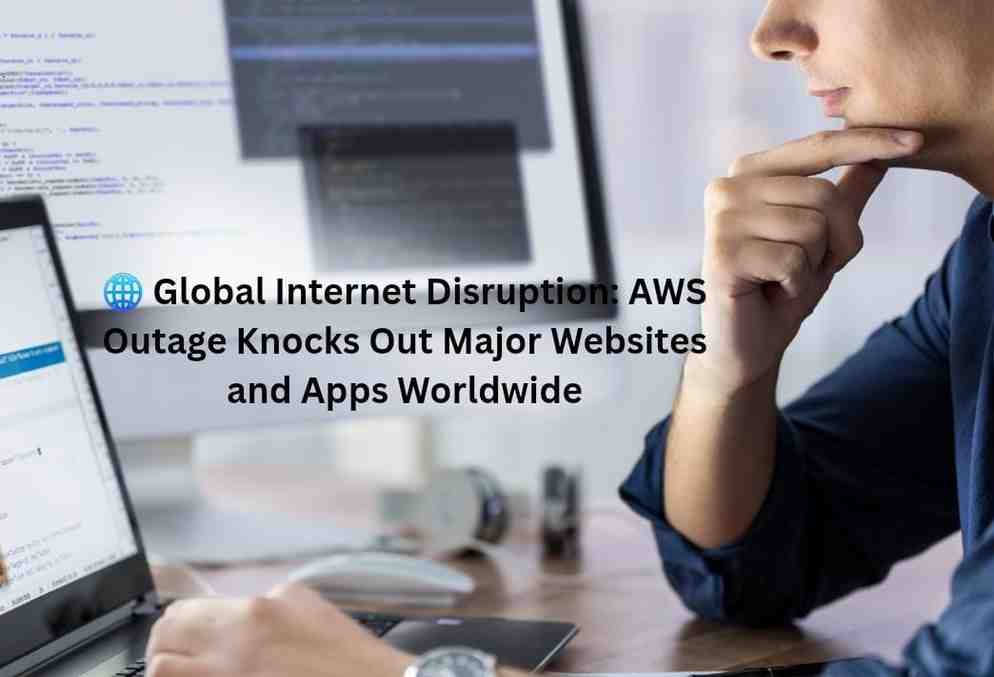Global Internet Disruption: Major Websites and Apps Go Down as Amazon’s AWS Suffers Widespread Outage

When the internet’s backbone stumbles, the whole world feels the shake. That’s exactly what happened on October 20, 2025, when Amazon Web Services (AWS) — the cloud engine that powers a large part of the digital world — went down, triggering a massive global disruption.
From shopping and streaming to gaming and finance, millions of users suddenly found themselves staring at error messages. Big names like Snapchat, Fortnite, Roblox, Lyft, Venmo, and even Amazon’s own services were affected by the outage.
What Exactly Happened?
Amazon’s cloud division reported “increased error rates and service latency” across several key systems, mainly within its U.S.-EAST-1 region — one of its busiest data hubs. The company’s official status dashboard confirmed multiple services were impacted at once, creating a domino effect across platforms that depend on AWS for hosting and real-time processing.
The disruption wasn’t confined to a few apps — it rippled across industries, shaking everything from entertainment and e-commerce to banking and logistics.
Platforms That Went Dark
According to outage tracker Downdetector, user complaints surged within minutes. Here’s a quick breakdown of what was hit:
- 🛒 Amazon’s ecosystem: the shopping site, Prime Video, and Alexa all experienced slow responses and temporary downtimes.
- 🎮 Gaming networks: Fortnite, Roblox, Clash Royale, and Clash of Clans servers were inaccessible, leaving gamers frustrated worldwide.
- 💳 Finance & trading apps: Coinbase, Robinhood, Venmo, and Chime reported transaction delays and login failures.
- 🚗 Ride-sharing & communication: Lyft and Signal confirmed operational interruptions.
AI startup Perplexity was among the first to publicly identify AWS as the cause. Its CEO, Aravind Srinivas, posted on X (formerly Twitter):
“Perplexity is down right now. The root cause is an AWS issue. We’re working on resolving it.”
Why AWS Outages Hit So Hard
To understand the scale, you need to know what AWS really is. It’s not just another tech brand — it’s the digital foundation of thousands of apps, platforms, and companies worldwide.
From AI startups to multinational corporations, AWS provides the computing power, data storage, and backend tools that make the modern web run smoothly. When it falters, entire online ecosystems can grind to a halt.
Despite strong competition from Google Cloud (GCP) and Microsoft Azure, AWS still holds the lion’s share of the global cloud market. That dominance is exactly why an outage of this size can cause a near internet-wide blackout.
How the Tech World Reacted
As expected, X (formerly Twitter) became the real-time bulletin board for updates and reactions.
Signal President Meredith Whittaker confirmed the messaging platform’s downtime, posting:
“Yes, AWS is down — and so are we.”
Meanwhile, Amazon’s engineers shared minimal updates, stating they were “actively investigating” and “working to restore services.”
The tech community echoed the same frustration — and a growing concern about global overreliance on a few cloud providers.
The Bigger Message
While this isn’t AWS’s first large-scale failure, the incident highlights a deeper issue: the internet’s fragility. With so much of our digital infrastructure concentrated in a handful of cloud networks, even a single point of failure can snowball into global chaos.
Experts say the key lies in cloud redundancy and multi-cloud strategies — where companies diversify their hosting providers to minimize risk. However, such transitions take time and significant cost, meaning AWS remains a single point of dependency for much of the online world.
What’s Next?
As of the latest reports, most affected services have gradually recovered. Still, users may continue to experience lag, login delays, or temporary errors. AWS engineers are reportedly monitoring the situation closely, though the root cause remains undisclosed.
Industry analysts expect Amazon to release a post-incident analysis soon, explaining what went wrong and how similar issues will be prevented in the future.
For now, this outage serves as a wake-up call — showing that even the world’s most powerful tech companies aren’t immune to downtime. In a world built on the cloud, a single outage can feel like the lights went out across the internet.